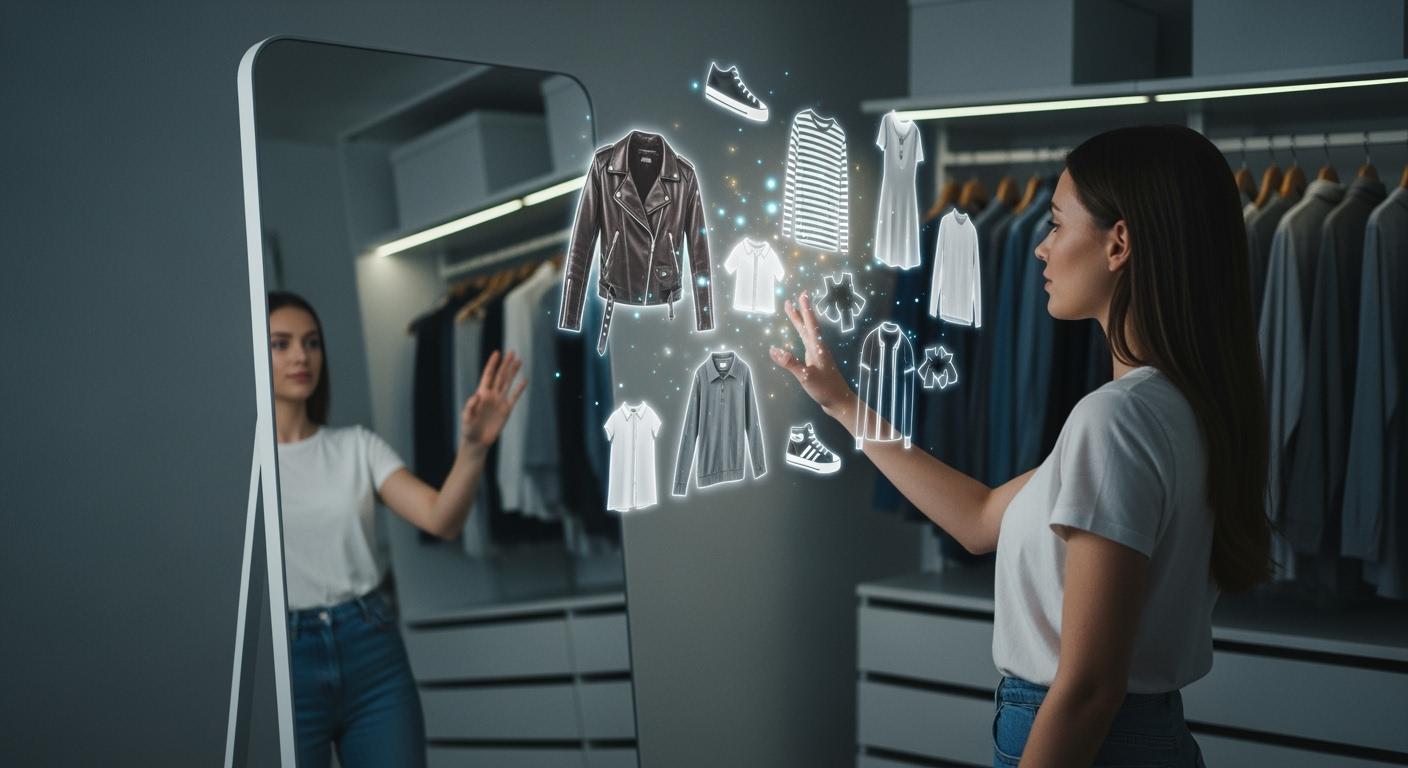
Fashion recommender systems now provide sophisticated outfit curation. This evolution moves beyond a single recommendation. The AI in fashion market reflects this trend, projected to hit USD 2.78 billion in 2025 and grow at a 39.43% CAGR through 2033. A new trend in fashion lifestyle curation uses AI and personal lifestyle data. This AI-powered outfit curation creates personalized outfit recommendations. This fashion lifestyle curation trend focuses on a customer's personal lifestyle. The fashion lifestyle curation trend delivers a customized fashion experience. The curation uses AI, personal lifestyle data, and sustainability. This fashion lifestyle curation trend makes each outfit personal. The curation trend considers social trends and a customer's lifestyle. The curation offers a unique fashion style. This fashion lifestyle curation trend helps each customer define their style. The curation uses AI data and lifestyle data for a better style recommendation. Sustainability is a key part of this fashion trend.
The AI Engine Driving Outfit Curation

The modern fashion experience is driven by a powerful AI engine. This engine transforms recommender systems from simple suggestion tools into intelligent style partners. The new trend in fashion lifestyle curation uses AI to understand a customer on a deeper level. This AI-powered outfit curation creates a truly customized wardrobe experience. The focus of this fashion lifestyle curation is a customer's unique lifestyle.
Personalized Outfit Recommendations
Today’s machine learning recommendation engines deliver personalized outfit recommendations that go far beyond past purchases. AI algorithms now analyze a rich variety of personal data points. This analysis creates a holistic view of the user's needs for better fashion curation. For instance, AI can interpret a user's mood through facial recognition or self-reported inputs to suggest an appropriate outfit.
This technology also enhances the personal shopping experience. AI uses computer vision to assess body type from uploaded photos, ensuring the fashion recommendation flatters the user's shape. It integrates with digital calendars to understand upcoming events. This allows the curation to suggest a professional outfit for a work trip or a festive look for a wedding. This lifestyle-based personal shopping makes fashion both intuitive and context-aware. The forecasting of needs is a key trend. This fashion lifestyle curation builds a dynamic personal wardrobe. The entire curation process is shaped by the user's daily lifestyle.
Visual Search and Image Recognition
Visual search technology is a cornerstone of modern digital fashion. Users can now upload an image of an outfit they admire to find similar items instantly. This "shop the look" feature bridges the gap between inspiration and purchase. AI systems identify specific garments, styles, and even textures from a single photo. This trend makes fashion discovery seamless and highly engaging for every customer.
This technology directly impacts the shopping experience and business outcomes. Search by image offers a faster path from inspiration to purchase. This approach aligns with modern consumer behavior, especially on mobile devices. Retailers see higher engagement and more efficient conversions.
Key Benefits of Visual Search:
- Increased Conversion Rates: Customers find what they want faster, which boosts sales.
- Enhanced Product Discovery: AI helps users discover new products, leading to a more exciting shopping journey.
- Intelligent Bundling: AI suggests matching items, increasing the chance of a customer buying a complete outfit.
Companies like Modelia are pioneering this space with tools like an 'AI Outfit Generator'. This allows users to style a complete look on a digital model. This trend also helps with digital wardrobe organization, as users can catalog their own clothes and receive recommendations on how to style them. This fashion lifestyle curation makes managing a personal wardrobe simple. The lifestyle of the user informs every recommendation.
Virtual Outfit Try-Ons and Fit Prediction
A major challenge in online fashion has always been fit. Virtual try-on technology and AI-powered fit prediction are solving this problem. These systems reduce the uncertainty of online shopping and promote sustainability by lowering return rates. Advanced sizing algorithms can decrease size-related returns by up to 35%. Some industry studies report that broader predictive analytics improve return rates by up to 60%. For example, lingerie retailer Playful Promises saw a 27% reduction in returns after implementing an AI fit recommendation system.
This technology uses several advanced methods to create a realistic digital try-on experience.
- Body Scanning with AI: AI algorithms analyze user photos or videos to create precise 3D body models. Systems like Prime AI's Size Finder can predict key body measurements from simple inputs like height and weight, creating a size-accurate digital avatar.
- 3D Modeling with AR: Augmented Reality (AR) overlays digital garments onto a user's real-time video feed. This allows a customer to see how a fabric drapes and moves from multiple angles.
- Advanced Fabric Simulation: A significant frontier in this trend is the digital replication of fabric behavior, including stretch, weight, and texture. This makes the virtual outfit look and feel more realistic.
While this technology is advancing, developers face challenges. Inconsistent product data, poor fabric representation in digital formats, and the high cost of manual data annotation can slow down AI development. Overcoming these hurdles is key to the future of fashion forecasting and personal style curation. This is a core part of the fashion lifestyle curation trend. The capsule wardrobe curation trend also benefits from accurate fit forecasting. This curation helps build a sustainable wardrobe. The future of fashion depends on this data. This curation makes personal style accessible. This curation reflects a modern lifestyle. This curation is a growing trend. This curation is central to a user's lifestyle. This curation makes fashion personal.
Lifestyle Integration and Social Trends

Modern recommender systems are evolving. They now integrate deep lifestyle data and social trends to offer a truly holistic fashion experience. This approach moves beyond basic preferences. It understands the context of a user's life. This fashion lifestyle curation makes style personal and relevant. The AI-powered outfit curation trend uses external data to enrich its recommendations. This curation reflects a customer's complete lifestyle.
Event and Lifestyle-Based Curation
AI algorithms now excel at event-based curation. This trend allows systems to build a wardrobe for specific life moments. This fashion lifestyle curation makes closets more meaningful. It connects personal stories to clothing. This curation is a key part of the modern fashion experience.
Several applications lead this lifestyle-based personal shopping trend.
- Acloset helps users create custom digital closets for seasons, work, or travel. Its AI offers style suggestions based on weather and calendar events.
- Plan My Attire provides occasion-based styling. It learns a user's style to suggest a daily outfit for work, events, or weekend plans.
- GetWardrobe syncs with a device's calendar. It uses this data to help users plan outfits for specific dates, informed by real-time weather forecasting.
This level of curation transforms a digital wardrobe into a dynamic planning tool. The system anticipates needs for a work trip or a wedding. This forecasting makes fashion intuitive. It aligns the wardrobe with a person's actual lifestyle. This curation trend builds a wardrobe that adapts to every part of a user's life.
Social Media and Influencer Styles
Social media platforms like TikTok and Instagram are the new runways for fashion trends. Recommender systems now use real-time trend spotting to keep users ahead of the curve. AI systems analyze posts, reels, and hashtags to identify emerging styles. This data allows for the instant recommendation of socially validated looks. This trend is central to modern fashion forecasting.
Apps use advanced techniques to map these digital trends. AI performs temporal analysis of hashtags like #Y2K or #CleanGirlAesthetic. It creates style profiles for influencers based on their post frequency and visual data. This process connects a customer directly to the pulse of fashion. The influence of this trend on shopping is powerful.
This influence is significant, as 74% of consumers have purchased a product based on a social media recommendation. Nearly half make at least one such purchase per month.
Influencers build trust and authenticity. Their recommendations convince consumers that a purchase is a valuable opportunity. This creates a powerful feedback loop. AI spots a trend, the system recommends it, and consumer purchases validate it. This cycle makes social media data essential for fashion lifestyle curation. This trend shapes the entire digital shopping journey.
Sustainability-First Recommendations
A growing consumer focus on sustainability is reshaping the fashion industry. AI is a critical tool in promoting ethical fashion choices. This technology provides the data and transparency needed for responsible curation. This trend helps a customer make informed decisions. This curation supports a more sustainable lifestyle.
AI algorithms enhance sustainability in several ways:
- Supply Chain Transparency: AI analyzes supply chain data to verify brand certifications and track products from raw material to finished garment. This helps identify risks like poor labor practices.
- Material Analysis: AI can identify sustainable material alternatives, such as eco-friendly fabrics with a lower environmental impact.
- Demand Forecasting: AI tools predict consumer demand with high accuracy. This forecasting reduces overproduction, a major source of waste in the fashion industry.
- Circularity: AI contributes to a circular economy by tracking a garment's lifecycle, identifying opportunities for reuse, recycling, or upcycling.
This data-driven approach helps users build a more conscious personal wardrobe. It is a core component of the capsule wardrobe curation trend. However, this trend also requires ethical vigilance. Brands may engage in "greenwashing," or misleading consumers about their environmental credentials. True sustainability involves fair labor and responsible resource management. AI-powered transparency is key to holding brands accountable and empowering the modern customer. This fashion lifestyle curation makes sustainability an accessible part of personal style.
The Future of Recommender Systems
The future of fashion recommender systems lies in proactive and creative AI. This evolution moves beyond suggesting what a customer might like. It now predicts what they will want. This fashion lifestyle curation is powered by advancements like multimodal AI, which processes text, images, and video together. Future systems will also use edge computing for faster, on-device processing and privacy-preserving techniques to protect user data. This creates a more intelligent and secure personal shopping experience.
Generative AI and Style Personas
Generative AI is transforming fashion from a process of discovery to one of creation. This technology creates novel style concepts from simple text prompts. A customer can experiment with new aesthetics before making a purchase. For example, AI tools can generate unique patterns or test different color options on a single design, speeding up creative work by up to 30%. This digital exploration helps a customer define their personal style.
This AI builds a deep understanding of each user, creating a unique style persona. Companies like Stitch Fix use generative AI to analyze customer feedback and generate images of new items that match a user's preferences. This fashion lifestyle curation makes the digital wardrobe deeply personal.
This AI-driven curation allows users to visualize and co-design their fashion future. It empowers them to explore aesthetics like
#Y2Kor abeach vacationlook, turning abstract ideas into concrete visual concepts for their lifestyle.
Predictive Curation and Trend Forecasting
Predictive curation allows a fashion platform to anticipate a user's needs. This forecasting uses AI to build a wardrobe for the future. The AI analyzes vast amounts of data for trend prediction. This process makes fashion lifestyle curation dynamic and forward-looking. This trend ensures a user's wardrobe evolves with their lifestyle.
This forecasting relies on powerful AI models for real-time trend spotting. These systems analyze data from multiple sources to identify the next big fashion trends.
- Social media posts and hashtags from platforms like TikTok and Instagram
- Historic sales performance and current market signals
- Runway shows and influencer-driven style data
This data-driven curation helps a customer stay ahead of trends. AI-powered forecasting also supports sustainability by helping brands predict demand more accurately. This reduces overproduction and waste. This fashion lifestyle curation builds a smarter, more responsive wardrobe that reflects a modern lifestyle. The capsule wardrobe curation trend benefits from this forecasting, creating a sustainable and stylish digital wardrobe.
Recommender systems are now intelligent lifestyle partners. This fashion lifestyle curation trend uses AI data for fashion forecasting. The AI fashion lifestyle curation trend shapes a personal lifestyle. AI fashion lifestyle curation offers personalized recommendations. This AI fashion lifestyle curation uses data for fashion forecasting. The AI fashion lifestyle curation trend makes fashion curation a part of a lifestyle. AI fashion forecasting data drives this curation. The AI fashion curation trend supports a sustainable lifestyle. AI data forecasting helps this fashion curation. AI data forecasting informs this fashion curation. This lifestyle-based personal shopping trend builds a personal style wardrobe. The AI fashion curation trend makes shopping a part of a lifestyle. AI fashion forecasting data shapes this style wardrobe. This fashion curation trend supports sustainability. The AI fashion curation trend builds a personal style wardrobe. This lifestyle curation builds a style wardrobe. This lifestyle curation builds a wardrobe.
FAQ
How does AI improve fashion curation?
AI analyzes data for better fashion curation. AI understands user style and current fashion trends. This AI curation creates a personalized experience. The AI makes fashion curation smarter.
Key Takeaway: AI transforms fashion curation from a simple suggestion tool into an intelligent styling partner. This AI technology makes the entire process more personal and effective.
What is lifestyle-based fashion curation?
This curation connects fashion to a user's daily lifestyle. AI suggests outfits for events or activities. This fashion curation builds a practical and personal wardrobe. The curation reflects real-life needs.
Can AI predict future fashion trends?
Yes, AI can predict fashion trends. AI systems analyze social media and sales data. This AI forecasting helps the fashion curation process. The AI curation stays ahead of new trends.
- Data Sources for AI:
- Social media posts
- Runway shows
- Sales figures
- Influencer styles
How does AI support sustainable fashion?
AI promotes sustainable fashion choices. AI tracks materials and reduces waste. This AI curation helps users build an ethical wardrobe. The fashion curation supports a green lifestyle and follows sustainability trends.
See Also
AI's Role in Managing Rapid Viral Trends for Fast Fashion
Machine Learning: Predicting Fashion Trends to Significantly Boost Sales
Balancing Fashion Supply and Demand Through Predictive Analytics Insights
Dynamic Safety Stock AI: The 2025 Solution for Fashion Retail
Optimizing Retail Re-stocking in 2025 Using Predictive Analytics